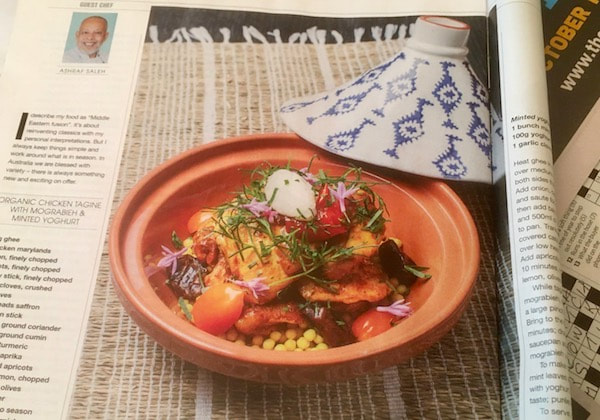|
Chicken Tagine with Mograbieh & Minted Yoghurt
This lovely chicken tagine is from Ashraf Saleh, who features as guest chef in the week-end magazine "Life" section of national newspaper, The Australian. Saleh is chef/owner of Coya in Sydney; his book Coya: French Middle Eastern Cuisine could break my "no more cook books" mantra. The recipe calls for an organic chicken. Now I'm as "woke" as your next foodie-eco-warrior but I must ask, would the recipe still work if I used a free-range chicken, or a corn-fed chicken, or a macro-biotic chicken? What about a harassed mum who just grabs a poor blighted supermarket chook on her way home? (A previous "guest chef" recipe called for free-range chicken pieces. Once again, would an organic chicken have ruined the recipe?) I'm being facetious here, but what do I require of a chicken?
Mograbieh is sometimes called pearl couscous, sometimes Israeli couscous, sometimes Lebanese couscous. It's now made specifically to size and dried. It was once a by-product of making couscous from scratch, by hand at home, something that is rarely done today. My mother could do it. I can do it, but rarely choose to. When the semolina is dampened in the open flat wooden bowl, and rolled and rubbed to create the fine grains of couscous, there are always some large ones formed, the size of a small pea, that are winnowed and set aside. Mograbieh is basically little round pasta. Whatever, it's a useful starch alternative, under stews or roasts or part of a salad. A Tagine is both a dish and the pot it's cooked in. If you make a tagine, (often a combination of meat, vegetables, sometimes dried fruit) but cook it in a covered saucepan or casserole, can it be called a tagine? A conundrum. Tagines are often just a decorative kitchen piece or an exotic serving dish, the earthenware base and funnel-like lid needing to be handled carefully. Le Creuset make a "modern" one with a cast iron bottom and red earthenware top. (There have also been good ones at a fraction of the cost at Aldi!) As the food simmers, the steam rises up the funnel and dribbles back down, round and round, like a retort in gin making. It does seem to create rich flavours. Perhaps there will be a mograbieh recipe and a tagine in my next post. And I'll make sure to get an organic, free-range chicken. Comment 👇 (See fine print)
6 Comments
Sue Lilley
22/10/2019 10:35:57 pm
Hi dear Cath, but where do you get an organic free range chook that tastes like it should ?
Reply
I think it's to do with food regulations and with what Australians will pay. Here chickens are rinsed with a bleach-like substance then wrapped in plastic which makes the skin clammy. In Europe the the skin is dry and "natural". You could pat it! Then here we want to pay about the same for a good chook as for a poorly-reared one. As the supermarkets say, "Down, down, the prices are down." The economics are not possible. Never rejoice when the prices are "down". It means the quality is also. Growers need to be rewarded for doing something well, not screwed as the dairy farmers have been.
Reply
Barbara Santich
23/10/2019 02:55:37 pm
I think that 99.9% of chickens sold in Australia are the same breed, raised by the same suppliers of day-olds to be fed and fattened, so in one way it doesn't much matter if they're organic, free-range or corn-fed (and in any case, the corn is a tiny proportion of the diet - it it were more, you'd be able to pick the yellow fat).
Reply
23/10/2019 03:51:19 pm
I have recipes for using "fresh" eggs! Don't really know of any that advocate stale eggs, (although slightly older eggs peel better when hard boiled) but stale eggs? No. Virtue signalling?
Reply
Jessica Knight
24/10/2019 08:38:25 pm
I once had a proper Tagine but it unceremoniously cracked so I now use my tried and trusted Le Crueset and I can't really say there is much difference and one forgets in the mist of time! I have finished reading Bee Wilson Cath, am about to embark on the next book.
Reply
25/10/2019 02:06:37 pm
Traditional tangines are hard to use on a modern stove. They crack, as you found out if not protected by a heat defusing mat (once asbestos). They're mainly used now to serve food. Look lovely but...
Reply
Leave a Reply. |
Categories
All
|

 RSS Feed
RSS Feed
